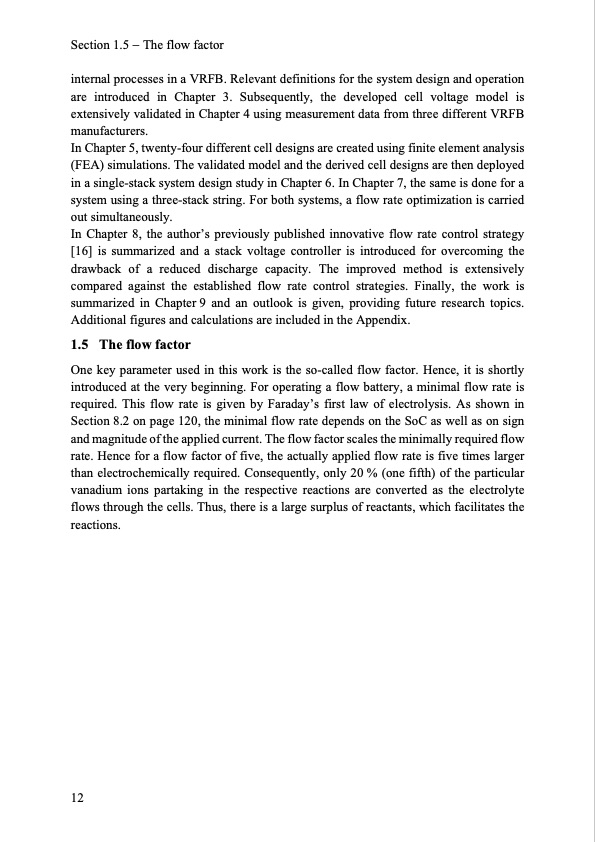
PDF Publication Title:
Text from PDF Page: 020
Section 1.5 The flow factor internal processes in a VRFB. Relevant definitions for the system design and operation are introduced in Chapter 3. Subsequently, the developed cell voltage model is extensively validated in Chapter 4 using measurement data from three different VRFB manufacturers. In Chapter 5, twenty-four different cell designs are created using finite element analysis (FEA) simulations. The validated model and the derived cell designs are then deployed in a single-stack system design study in Chapter 6. In Chapter 7, the same is done for a system using a three-stack string. For both systems, a flow rate optimization is carried out simultaneously. In Chapter 8, the author’s previously published innovative flow rate control strategy [16] is summarized and a stack voltage controller is introduced for overcoming the drawback of a reduced discharge capacity. The improved method is extensively compared against the established flow rate control strategies. Finally, the work is summarized in Chapter 9 and an outlook is given, providing future research topics. Additional figures and calculations are included in the Appendix. 1.5 The flow factor One key parameter used in this work is the so-called flow factor. Hence, it is shortly introduced at the very beginning. For operating a flow battery, a minimal flow rate is required. This flow rate is given by Faraday’s first law of electrolysis. As shown in Section 8.2 on page 120, the minimal flow rate depends on the SoC as well as on sign and magnitude of the applied current. The flow factor scales the minimally required flow rate. Hence for a flow factor of five, the actually applied flow rate is five times larger than electrochemically required. Consequently, only 20 % (one fifth) of the particular vanadium ions partaking in the respective reactions are converted as the electrolyte flows through the cells. Thus, there is a large surplus of reactants, which facilitates the reactions. 12PDF Image | Model-based Design Vanadium Redox Flow Batteries

PDF Search Title:
Model-based Design Vanadium Redox Flow BatteriesOriginal File Name Searched:
10-5445IR1000070670.pdfDIY PDF Search: Google It | Yahoo | Bing
Salgenx Redox Flow Battery Technology: Salt water flow battery technology with low cost and great energy density that can be used for power storage and thermal storage. Let us de-risk your production using our license. Our aqueous flow battery is less cost than Tesla Megapack and available faster. Redox flow battery. No membrane needed like with Vanadium, or Bromine. Salgenx flow battery
| CONTACT TEL: 608-238-6001 Email: greg@salgenx.com | RSS | AMP |